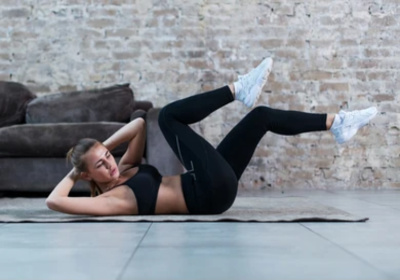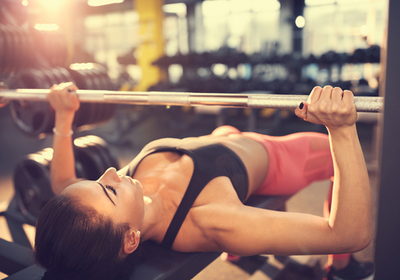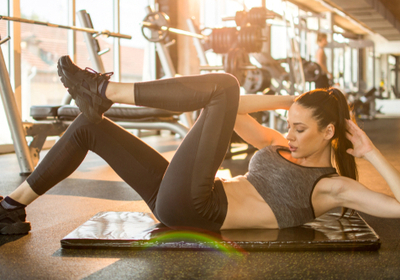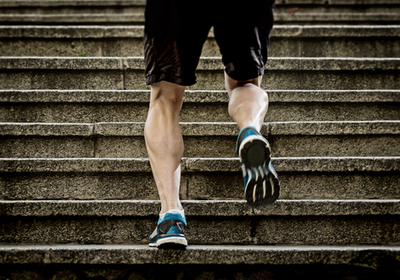VIDEO
Mountain Climbers
- Core
- Legs
- Abs
- Gluteus
- Hips
Level:Intermediate
Trainer:Nick Anderson
Equipment:No Equipment
Mountain Climbers
- Core
- Legs
- Abs
- Gluteus
- Hips
Level:Intermediate
Trainer:Nick Anderson
Equipment:No Equipment
Stand on your knees and hands (tabletop position). Your hands should be directly under your shoulders the whole time of the exercise. Then begin to bring your knee under the chest, switching the legs each time.
save to ...
RECOMMENDED FOR YOU
V-sit Leg Extension, Seated Crunches, Plank Crunches Variation
- Core
- Arms
- Legs
Duaration: 00:15
save to playlist
Side Elbow Plank Variation, Elbow Plank Hip Dips, Bicycle Crunches
- Core
- Arms
- Abs
Duaration: 00:15
save to playlist
Barbell Ab Roller
- Core
- Upper Back
- Shoulders
Duaration: 00:48
save to playlist
Reverse Crunch
- Abs
- Lower Back
- Obliques
Duaration: 00:39
save to playlist
Stair Running, Scissors
- Core
- Biceps
- Triceps
Duaration: 00:15
save to playlist
Depth Jump to Sprint
- Core
- Quads
- Hamstrings
Duaration: 00:56
save to playlist
Cat Cow
- Upper Back
- Lower Back
- Gluteus
Duaration: 00:20
save to playlist
Half Handstand Variation with High Knee Jumps
- Core
- Arms
- Legs
Duaration: 00:15
save to playlist
Squat Variation, Long Jumps, Squat Jump, Squat with a Leg Kick
- Core
- Legs
- Gluteus
Duaration: 00:15
save to playlist
Plank Knee to Elbow Variation, Mountain Climbers, Elbow to High Plank, Plank Jumps
- Core
- Arms
- Legs
Duaration: 00:15
save to playlist
Air Plane Abs
- Abs
- Obliques
Duaration: 00:20
save to playlist
High Knees
- Gluteus
- Hamstrings
- Hips
Duaration: 00:30
save to playlist
Sit-Throughs
- Core
- Biceps
- Lower Back
Duaration: 01:05
save to playlist
Reverse Plank Leg Lifts, Long Arm Crunches, Twist Plank Variation, Long Arm Vertical Crunches
- Core
- Legs
- Abs
Duaration: 00:15
save to playlist
Pushups, Long Jumps, Lunge Variation, Sumo Squats, Squat Jumps, One Legged Jumps, Reverse Leg Lifts
- Core
- Arms
- Legs
Duaration: 00:15
save to playlist
Inch Worms
- Core
- Triceps
- Upper Back
Duaration: 00:30
save to playlist
Mountain Climbers, Crunch Variation, Crunch with Knees to Chest, Jumping Rope
- Core
- Arms
- Legs
Duaration: 00:15
save to playlist
Bench Jumps
- Core
- Legs
- Hips
Duaration: 00:15
save to playlist
Box Jump
- Core
- Gluteus
- Quads
Duaration: 00:43
save to playlist
Downward Facing Dog, Four Limbed Staff, Side Plank Hip Lifts, Side Plank Crunches
- Core
- Arms
- Back
Duaration: 00:15
save to playlist
Pushup Variation
- Core
- Biceps
- Shoulders
Duaration: 00:15
save to playlist
Clam Shell in Supine Position, Glute Bridge Knees In And Out, Side Plank Leg Lifts Variation
- Legs
- Lower Back
- Gluteus
Duaration: 00:15
save to playlist
Kettlebell Single Arm Thruster
- Back
- Biceps
- Shoulders
Duaration: 00:38
save to playlist
Downward Dog to Knee Drive
- Back
- Abs
- Shoulders
Duaration: 00:20
save to playlist
Donkey Kicks, Fire Hydrant, Elbow Plank Jumping Jacks, Plank Knee To Elbow
- Abs
- Gluteus
- Hamstrings
Duaration: 00:15
save to playlist
Squats with Oblique Crunches, Toe Touch Sit Ups, Elbow Plank Leg Raises, Squat Front Kick
- Abs
- Lower Back
- Obliques
Duaration: 00:15
save to playlist
Front Squat Lunge, Standing Glute Kickback
- Lower Back
- Shoulders
- Gluteus
Duaration: 00:15
save to playlist
Jumping Jacks Squat
- Gluteus
- Quads
- Hamstrings
Duaration: 00:15
save to playlist
Elbow Plank with Leg Lift, Elbow Plank Twist, Crunch Twist, Downward Facing Dog, Plank Jump, Scissors
- Core
- Arms
- Legs
Duaration: 00:15
save to playlist
Single Leg Squat Variation, Squat to Side Lunge, Squat Jump
- Gluteus
- Quads
- Hamstrings
Duaration: 00:15
save to playlist
Squats with Jumps, Side Lunges, Lunges, Standing Forward Leg Lifts, Plank Jumps Variation
- Core
- Legs
- Gluteus
Duaration: 00:15
save to playlist
Depth Jump to Jump
- Core
- Lower Back
- Gluteus
Duaration: 00:49
save to playlist
Front Plank to Side Plank, Plank Knee to Elbow, Plank Leg Lifts
- Abs
- Biceps
- Triceps
Duaration: 00:15
save to playlist
Planche
- Core
- Biceps
- Triceps
Duaration: 00:15
save to playlist
Breakdancer Plank
- Core
- Abs
- Biceps
Duaration: 00:13
save to playlist
Single Leg Squat
- Core
- Legs
- Gluteus
Duaration: 00:30
save to playlist
Twist Up
- Abs
- Biceps
- Triceps
Duaration: 00:16
save to playlist
Plank Knee to Elbow, Mountain Climbers
- Abs
- Triceps
- Trapezius
Duaration: 00:15
save to playlist
Seated Inner Leg Side Lifts, Sumo Squats, Squats with Jumps, Side Lunges
- Legs
- Gluteus
- Hips
Duaration: 00:15
save to playlist
Russian Twist, Double Leg Stretch, Side Plank Leg Lift
- Core
- Back
- Abs
Duaration: 00:15
save to playlist
Blog
The oblique muscles are several groups of abdominal muscles located on the sides of the core. The external oblique muscle lies on top and the internal oblique is underneath. Functional exercises for their training are inclinations, turns to the sides, and other rotating movements. However, in order to properly build lateral muscles, you need to remember that most oblique exercises involve the other abdominal muscles, in particular, the internal transverse muscles. That is why it is necessary to be able to consciously involve certain areas of abs.
Best Exercises for Obliques
1. Side crunchesThe basic exercise for the oblique muscles of the abdomen is the lateral twisting of the lying. Starting position: lying on your side, an arm bent at the elbow supports the head. Slowly stretch your elbow towards your legs, making a movement to deliberate contraction of the oblique abdominal muscles.
2. Side crunches on the backThis exercise is useful for developing the neuromuscular connection between the abdominal muscles and the brain. Lying on your back, slowly stretch your left elbow towards your right knee. Do 12-15 repetitions for each side, trying to achieve a particular burning sensation.
3. Side crunches on the fitballThe benefit of this exercise lies in the wide range of motion achieved by slowly and controlled bending of the body on the ball. While lifting, feel the twisting of the side press, while lowering, feel the stretch. Keep your hands behind your neck and do not spread them apart.
4. Cross contactsFirst, lie on your back with both legs extended upward. Your hands should be placed on the back of the head, slightly raise your head and shoulder blades. After that, do the twist, reaching the leg with a straight opposite hand. Repeat the same steps for the other side. Do at least twenty repetitions.
5. Hips liftingLie on one side and make sure that you are lying straight. Your legs should lie on top of each other and your free hand is fixed on the belt. Your task is to raise the body so that at the peak amplitude the body line is fully straightened. At the top point, a small pause is made to emphasize the work of the oblique muscles. When lowering the torso, the thighs only lightly touch the floor, the muscles do not relax completely.
Final Word
Developed oblique muscles frame your abs and make them look simply stunning, so if you really want to have a gorgeous abdomen, you have to work on both your abs and obliques.
Read more
Chest muscles are among the hardest ones to train yet strengthening these muscles is totally possible. In this article, we are going to talk about chest muscles and how to train them.
How to Develop Chest Muscles
Developed chest muscles are a vivid indicator of hard work on the body. This muscle group is one of the largest and most complex in the human body. Complete training demands to combine basic and isolating exercises. This is the only way to build the muscles in perfect shape. Barbell exercises are more suitable for increasing muscle mass, and with dumbbells and equipment - for improving the shape and detailed work. It is a bad idea to use really heavyweights in the beginning. It’s much better to learn how to feel the work of the necessary muscles during working out your chest, your arms and shoulders. For example, classic push-ups from the floor will help you feel your chest muscles and understand how they work. For a proper workout, you need to use a variety of dumbbell chest exercises to work the muscles at different angles.
Workouts for Chest
Dumbbell bench pressPlace the dumbbells near your hands. Start by taking the correct position. The back of the head, back and pelvis are pressed to the bench. The heels are pressed into the floor, the legs are separated by 60 degrees. Memorize the position, sit down, grab the dumbbells, and put them on your knees. Lie down while getting the dumbbells to your chest. Extend your arms, leaving a slight angle at the elbow joint, keeping the dumbbells in parallel. Start the chest exercise with a smooth lowering of the weight, moving your elbows to the up and down. When you feel a stretch in your pectoral muscles, return your arms to their original position.
HammerStart it with the right position. Sit on the edge of a bench with the dumbbells on your knees. Lie down tightly pressing the back of your head, back, and lower back to the bench. At the same time, shift your weight from your hips to your chest. Raise your arms in front of you, keeping a 90-degree angle. The palms are turned towards each other, the elbows are slightly bent. Bend your arms as you inhale, bringing the dumbbells to your chest. During the exhalation, unbend focusing on the tension of the pectoral muscles. Repeat it. The Hammer adds extra tension to the triceps, so it's important to focus on your chest muscles. The exercise must be done slowly, and it requires concentrated work. It is great for beginners and athletes recovering from chest, shoulder, or elbow injuries.
Dumbbell PulloverLying on a bench, the back of the head, shoulders and buttocks are kept to the surface, the feet stand firmly on the floor, the hands hold the dumbbells on the chest line with one hand on the other. Fix it and raise the dumbbell over your head, doing a slight bend of the elbow. Exhaling, gently lower the dumbbell behind your head, focusing on stretching the pectoral muscles. Only the shoulders work in the process. Having reached the maximum tension in the lower amplitude, return your arms back along the same trajectory. This exercise with dumbbells on the chest is optional, therefore it is more logical to use it in the mix with basic exercises. It helps to stretch the chest muscles, as well as increase the shape of the chest. Make sure that the head is supported in this position. Otherwise, the risk of straining the cervical muscles or pinching the nerve becomes critical. Work the dumbbell smoothly, avoiding sudden jerks and extreme weights.Also don’t forget that some pre-workout warm-ups are great for increasing your stamina and recovery, but don't rely on them all the time. Getting the right amount of sleep and proper nutrition are two of the most important factors in increasing your gym performance.
Final Thoughts
Exercises for your chest will help you improve your relief as well as general health, so make sure to train these muscles at least a little bit while working out.
Read more
The path to beautiful abs should not start with the question 'How to strengthen abdominal muscles?' The thing is that the visual image of a flat stomach depends on the percentage of body fat. This means that the way your abs will look not only depends on the number of crunches you do but on the quantity and quality of your food. So today we are going to talk about the tips for getting gorgeous abs.
Abs vs Food
Nutrition is extremely important for getting abs. In fact, your coach will probably give individual nutrition recommendations after testing, but there is one universal rule that everyone should follow - eat healthy food. In particular, you should avoid eating bakery, sugar-containing foods, and salty snacks. On the contrary, you have to eat more vegetables, fruits, herbs, nuts and seeds, as well as meat or other high-protein foods.
Getting Started
Before starting a workout, it is important to obtain data on your body condition. This means that the best place to start is fitness testing. Your trainer will ask you some questions in order to learn about your lifestyle, test your ability to move, and measure you. Then the coach will recommend the activities that will be safe and effective for you.
Popular Abs Workouts
It is believed that the best ab exercises are the training of the rectus abdominis muscles, which perform the function of flexing the body and keeping it upright. But this is just the tip of the iceberg. You also want to work on the deep muscles, which are part of your core and include the muscles of the abdomen, back, thighs, and buttocks. Their function is to help the body maintain posture and balance in an upright position. As a matter of fact, if your core is not strong enough, you will most likely experience discomfort while doing other exercises. Strengthening the core should be your top priority and you can do that with the help of TRX loops, plank and its variations, as well other bodyweight exercises.
Exercises for Strengthening Core and Abs
As we have mentioned above, to have gorgeous abs, you have to make sure you not only work on your abdominal muscles but on your entire core. So here are some exercises for improving all these muscles:
Diagonal twists
Plank
Pushups
Plank push-ups
Crunches
Leg lifts from lying position
Wrapping Up
As you can see, getting gorgeous abs is totally possible if you know how to work on them. Healthy nutrition and regular exercises will help you sculpt the body of your dreams, so do not hesitate and start going toward your dream now.
Read more
The calf muscles are often neglected in the early training stages when people concentrate on working out the chest, arms, and back. As a result, exercises for building calves are postponed or performed extremely rarely, which leads to a lack of progress. The muscles of the lower legs, as well as the deep muscles of the back, practically do not rest during the day, as they have to bear the weight of the body, help maintain balance, and stabilize the joints when walking. This means that it is focused on a low level of development and the way of working with it should be different.Here are some exercises for calves.
Calves 45Among all the exercises this one is aimed at developing the calf muscles, it is also one of the most difficult ones. It's all about changing the angle of the legs, which allows you to use not only the calves but also the soleus. To perform this exercise, you need Gakkenshmidt's Machine. Depending on the design, you will be facing it or not. Set a suitable operating weight. It is calculated as the arithmetic average between the working weights in the two previous exercises. Next, select the weights according to the loads. Then you need to lower the heels, trying to stretch the calf as much as possible. Perform a toe lift. Lock in the position of extreme tension for 1-2 seconds.
Calf raises with dumbbellsThis exercise is designed for athletes of any level and is considered the main one for working out the calf muscles. Stand on a wooden block. You can perform a movement in Smith, getting a step platform under your feet, and put the barbell on your shoulders. Fix the body in a straight position. If additional weight is required, dumbbells or weights should be taken. Next, you need to lower your heels below the level of the bar, trying to stretch the ankle as much as possible. Rise on your toes with a powerful impulse movement. Stay in this position for 1-2 seconds and tighten the calves. Slowly lower and get back to the starting position.
Seated calf raisesThis exercise is great for lazy training and will be a perfect option for beginners. Sit on the machine seat. Place the toes of the feet on the support step. Lower your heels to the floor as much as possible. Lower the lever with soft stops on your knees and lock.
Leg pressLie on a leg press machine. This uncommonly effective device for working out the legs can be used for training the calf muscles. Look for the platform where the legs would be straight. Fix the speed. You only need to do two actions. Remove the platform from the stops and squeeze it out with your toes. Return the socks to their original position.
It is important to know that the effect of posture on the development of the lower leg and calf muscles is much stronger than the effect of training. Flat feet, if not taken into account and not compensated, also interfere with bringing the shape of the lower leg. To improve your calves without exercising machines, you can simply choose the right shoes and adjust your gait.
Wrapping Up
Developed calves not only help you perform certain exercises better but also make your legs look simply gorgeous. Therefore, take another look at these exercises and make sure to at least give them a try while working out next time.
Read more
Before choosing the best exercises for the deltoid muscles, you should learn their structure. These muscles consist of three parts, and in order to achieve good results, you need to pay attention to each of them to ensure their harmonious development. And in this case, there is a whole set of exercises aimed at parallel and sequential working out of all ligaments of deltoid muscles.
Best Exercises for Deltoid Muscles
In order to have strong deltoids, you have to regularly train them, which is why we suggest you take a look at these exercises for deltoid muscles.
Sideways dumbbellsIf you are interested in building the back delta of the shoulder, then this workout is what you need. This exercise extensively involves not only the deltoid but also the trapezius muscles. Take the dumbbells with a neutral grip and lean forward slightly, keeping your back straight, and the dumbbells should now be raised to the ear level. To do this, you need to bend your elbows and take the starting position by slowly lowering your arms.
Front liftThrough this exercise, you can achieve excellent upper muscles and the muscles of the trapezium. Take the dumbbells while being in a sitting position. Lower your hands. Now you should lift the dumbbell to the point parallel with the floor. At the same time, the arm remains straight. When you reach shoulder level, stop. Lower the dumbbell in the same way. Do the same with the other hand.
Lifting sidewaysExperts recommend carrying out these exercises for effective pumping of the lateral deltoid muscles. The effectiveness of the exercise depends on the correctness of the exercise, therefore strictly follow these instructions: Stand up straight with dumbbells in your hands. Now slowly lift the dumbbells. Once the dumbbells are at your shoulder level, you should stay in this position. After that, slowly lower our arms, thereby returning to the starting position.
Barbells pressTake the shell on your chest, bring your elbows forward, tighten your abs, buttocks, and legs. Lift the bar up, lower it back and repeat. When the bar passes your face, do not lift it upper, but put it to yourself: this way the bar will go along the optimal trajectory. If at the top point the projectile remains in front of the body, and not above it, the load on the lower back increases. Therefore, try to take the barbell behind your head. Do three to five sets of six to eight reps.
Handstand push-upsThis exercise movement itself repeats the barbell press up in a reduced range. Stand in a handstand with your feet on the wall. Bend your elbows, lower yourself and touch the floor with your head. Put yourself back and repeat. Place your head on the floor more carefully (careless movements can damage your neck). To make the exercise easier, place something under your head, such as a rolled blanket or several thick books. To complicate things, place firm support under your arms. Perform as many times per set as you can. Do 3-5 approaches, depending on how you feel.
Wrapping Up
Developed deltoid muscles will make you look athletic and simply stunning, so if you dream of a beautiful body, make sure to do some of these exercises.
Read more
SAVE TO ...





